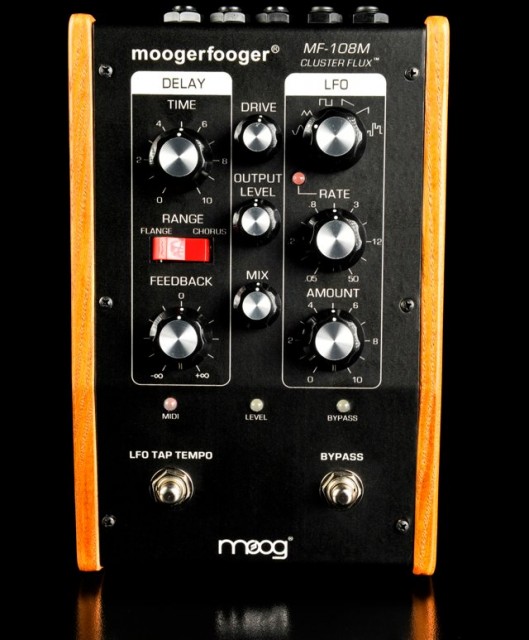There’s a new analog Moog effect in town. So who better to tell us about it and get us some hands-on time than Moog Music’s Chief Engineer?
Moog’s next Moogerfooger, the Cluster Flux or “MF-108M” if you want to sound more serious, promises to be a versatile analog effect processor. It’s a flanger / chorus / vibrato unit with loads of modulation, meaning you can either go the classic chorus/flange route or go further out with your sound sculpting. Mono in, stereo out, all-analog signal path, coming soon at US$599 list (street should be lower).
That’s the unit. But I often find it’s most interesting to talk to the people who actually design the gear. At our Handmade Music event, presented with Moog and curated by myself and Wilco’s lead keyboardist Mikael Jorgensen, we had gathered a bunch of makers of musical devices, from independent one-off production to, well, Moog. Getting to talk to each other was a real gift; makers confessed what attracted them to electronic music instrument making, and the trial and error necessary to make something. (Yes, there are even trials with experienced engineers at mighty Moog.) Videos of all of that will be appearing in the coming days.
Cyril Lance is Chief Engineer at Moog. He’s the guy who’s led a lot of the work behind the MF-108M and many other recent Moog Music inventions. When he talks about the Cluster Flux, it seems he can barely contain a certain glee at why he’s excited to produce it, and what he believes makes it special. And we had a blast with him, not only talking Moog but playing with everything else in our Handmade Music Lounge.
This isn’t a review; it’s a chance to listen to one of the makers of the box talk directly about why it makes him happy. I look forward to getting a Cluster Flux when it’s ready. Our impromptu sound is, not surprisingly, less-than stellar. So, I asked Moog Music to record for CDM some exclusive audio snippets of the Moogerfooger in action – totally dry, just a Moog guitar, the MF-108M, and an amp. Sounds included via the CDM SoundCloud account below:
Moogerfooger Cluster Flux MF-108 – Exclusive Demo Sounds by cdm
Otherwise, you’ll have to take my word for it: whether this box is for you or not, I have to say, it sounds really brilliant. I spent a big chunk of the afternoon with our MeeBlip open source synth hooked up to the Cluster Flux, and I could get used to the combination. (Glad we could share the MeeBlip with Moog, too!)
Coming soon: videos of some of the other folks we shot at Mass MOCA, conversations about making, and a broader chat with Cyril about what it’s like running engineering for Moog (and, incidentally, why he’s excited about the DIY movement, even if it might make things that compete with Moog’s own offerings).
More on the Moogerfooger:
Moogerfooger Cluster Flux: Flanger + Chorus + Vibrato + LFO; Pricing and Availability Details [CDM]
Coming Soon: The Moogerfooger MF-108M Cluster Flux [Moog Music News]
And some specs/features (most illustrated in the video above):
LFO waveforms: Sine, Triangle, Square, Saw, Ramp and Random
MIDI in, for control of Delay Time, Range, Feedback, Output Level, LFO Waveform, LFO Rate, LFO Amount and Mix
CV control of Delay Time, LFO Rate, Feedback, LFO Amount, Mix
LFO sync to MIDI Clock or Tap Tempo
Send/Return Insert for external processing of BBD feedback loop
Configurable Stereo Out
Spillover mode, for “drones and other feedback effects” (actually, didn’t get to play with this one, so we’ll have to do that in the review … I love me some drones.)
Delay Time, Mix, and Feedback configurable in Chorus
Wide-ranging LFO rate (yeah, this bit is a lot of fun)
Bi-polar feedback for flanging, even or odd harmonic emphasis (again, lots of fun, got to play a little but hope to play more)
Full details on the Moog site; more to come.
“Bi-polar feedback” sounds a little bit like Web comments, so it’s worth saying this: I heard the feedback loud and clear that you’d like to see a wider variety of coverage of this kind of gear. We’re on it. It takes some time, but I’d absolutely love to see this kind of coverage — looking in-depth at the gear and talking to the maker — of more devices. And whatever our name may or may not imply, that includes hardware as well as software, analog as well as digital. (Analog and digital circuitry coexist in most gear these days in some sense – certainly, you can find something digital in almost anything analog since the year I was born, so our name lets us do whatever we want.)
